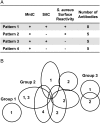Staphylococcus aureus manganese transport protein C is a highly conserved cell surface protein that elicits protective immunity against S. aureus and Staphylococcus epidermidis
- PMID: 22474033
- PMCID: PMC3348682
- DOI: 10.1093/infdis/jis272
Staphylococcus aureus manganese transport protein C is a highly conserved cell surface protein that elicits protective immunity against S. aureus and Staphylococcus epidermidis
Abstract
Staphylococcus aureus and other staphylococci cause severe human disease, and there are currently no vaccines available. We evaluated whether manganese transport protein C (MntC), which is conserved across the staphylococcal species group, could confer protection against S. aureus and Staphylococcus epidermidis. In vivo analysis of S. aureus MntC expression revealed that expression occurs very early during the infectious cycle. Active immunization with MntC was effective at reducing the bacterial load associated with S. aureus and S. epidermidis infection in an acute murine bacteremia model. Anti-MntC monoclonal antibodies have been identified that can bind S. aureus and S. epidermidis cells and are protective in an infant rat passive protection model and induce neutrophil respiratory burst activity. This is the first description of a protein that has the potential to provide protection across the staphylococcal species group.
Figures



References
-
- Josefsson E, Hartford O, O'Brien L, Patti JM, Foster T. Protection against experimental Staphylococcus aureus arthritis by vaccination with clumping factor A, a novel virulence determinant. J Infect Dis. 2001;184:1572–80. - PubMed
-
- Gill SR, Fouts DE, Archer GL, et al. Insights on evolution of virulence and resistance from the complete genome analysis of an early methicillin-resistant Staphylococcus aureus strain and a biofilm-producing methicillin-resistant Staphylococcus epidermidis strain. J Bacteriol. 2005;187:2426–38. - PMC - PubMed
-
- Piette A, Verschraegen G. Role of coagulase-negative staphylococci in human disease. Vet Microbiol. 2009;134:45–54. - PubMed
Publication types
MeSH terms
Substances
LinkOut - more resources
Full Text Sources
Other Literature Sources
Medical

